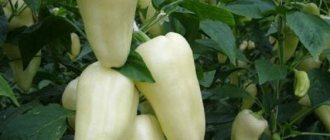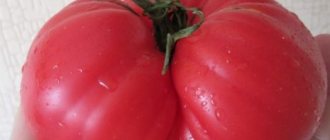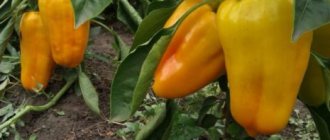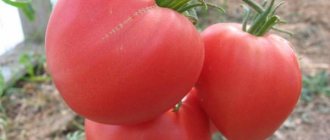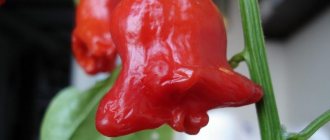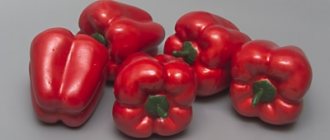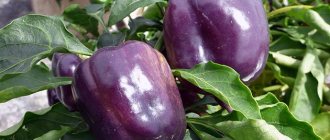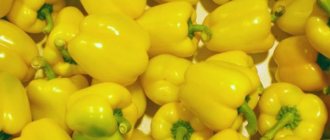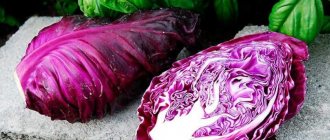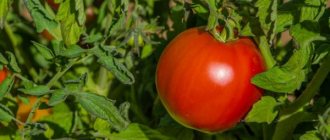Pepper Yellow Bell: description of the variety and main characteristics
The bushes of this pepper are relatively compact, although their shoots are slightly spreading, well-leafed, the height of the stems is up to 0.7-0.75 m, the color of the shoots is rich emerald. The foliage is medium in size, ovoid in shape with sharp tips and small jagged edges, the surface is wrinkled with a characteristic shine, bright emerald color.
The variety is late-ripening - from the moment the seedlings are planted in a permanent place to the harvest of ripe products, it takes about 2.5 months
.
Interesting!
The shape of ripe drooping fruits is cuboidal, the peppers look like yellow inverted bells, hence the name of the variety.
The surface is flat, smooth, glossy. The average weight of ripe peppers is about 160-165 g. The walls are thick, fleshy, their thickness can be up to 9 mm. The pulp is juicy, with good taste, without bitterness.
In a state of technical ripeness, the color of the fruit is a delicate salad color, after full ripening it is bright yellow.
The variety is for universal use; its fruits are used fresh, added to salads and snacks; stuffed peppers of this variety are especially tasty. Ripe yellow peppers are used to decorate ready-made dishes. It is also added when preparing hot dishes, canned - for making lecho and other twists, and frozen.
The harvested crop tolerates transportation well over different distances and has good shelf life.
Pepper Yellow Bell - photo
Features of the variety
“Yellow Bell” is an early ripening variety in terms of ripening speed.
It received this name due to its large size and characteristic yellow color. The fruits are shaped like inverted bells. The weight of each of them can be from 100 to 200 grams. Thick walls and fruit length up to 12 cm make it very attractive to many gardeners. The bushes of the plant usually do not exceed 75 cm. At the same time, they have medium foliage with small green leaves.
Yellow Bell Productivity
The Yellow Bell pepper variety is characterized by good productivity: when grown in closed ground, up to 7.5-8.5 kg of ripe products are collected from one square, and when grown in garden beds - up to 5.5-6.5 kg.
Advantages of the variety
The main advantages of this variety include:
- high yield, and 7-10 fruits can ripen on the bushes at the same time;
- good taste, pleasant aroma and beautiful appearance of ripe fruits;
- versatility of purpose of the harvested crop;
- ripe fruits tolerate transportation well over different distances;
- good keeping quality of peppers.
No particular disadvantages were noted in the Yellow Bell pepper. However, due to the late ripening of the crop, not all fruits have time to ripen during the season. But in this case, they are collected at the stage of technical maturity and left to ripen in room conditions.
Rules for planting sweet peppers Yellow Bell
Seedlings of this pepper should be planted in a permanent place at the age of 2 months; in this case, young plants do not outgrow, so they take root well in a new place, practically do not get sick and grow quickly.
Based on this, the approximate time for planting seed material for seedlings is calculated.
Pepper varieties:
Bogatyr pepper Sweet pepper Player Oriole pepper
To plant seeds, you can purchase commercial soil for bell peppers in specialized stores, or prepare it yourself at home.
To do this, mix turf and rotted compost in equal parts, and add wood ash to the resulting mixture. To make the substrate loose, you need to add river sand, high-moor peat and rotted sawdust.
Before putting the prepared soil into containers, you can calcine it in the oven at 180 degrees for about half an hour, or spill it with a weak solution of potassium permanganate. The containers in which the seedlings will be grown are also disinfected with potassium permanganate.
Growing sweet peppers from seed planting to harvest
Store-bought Yellow Bell pepper seeds require no prior preparation.
And seeds collected independently from grown vegetables must be subjected to the following processing before planting:
- Place in a weak solution of potassium permanganate for 1/3 hour, then wash under running water;
- For 1/3 of the day they are placed in a solution of a growth stimulator.
- Then the seeds are wrapped in damp gauze and left to germinate for several days.
When the seed material germinates, it is sown in a container with a moistened substrate, deepened by 0.5 cm. The distance between the seeds is at least 2 cm.
Since the roots of peppers are delicate, they do not tolerate picking and transplanting well, so experienced vegetable growers recommend immediately planting the seed material in separate cups.
After planting, the containers are covered with polyethylene and moved to a warm, dark place. Sprouts appear in about 6-8 days.
After this, the polyethylene is removed and the containers are moved to the windowsills. For normal growth and development, seedlings need 12 hours of daylight. If there is a lack of lighting, plants should be supplemented with light, otherwise they begin to reach for the light, as a result the stems stretch too much, which is why the seedlings become weak.
Watering pepper seedlings is carried out as the soil dries. These plants cannot be overwatered.
If the seeds were planted in large containers and the plantings were thickened, then they should be plucked when the seedlings have at least 2 true leaves.
12-14 days after picking, you should feed the peppers with mineral fertilizer for seedlings
. After a couple of weeks (but no later than 12-14 days before planting in open ground), such fertilizers are applied again.
A couple of weeks before planting the seedlings in the beds, they should be hardened off - taken out into the fresh air, first for an hour, gradually increasing the time the seedlings spend outside.
The area for planting pepper seedlings should be well lit by sunlight and protected from gusts of cold wind. The soil on the site should be loose and fertile, preferably loamy or sandy loam. Compost (or humus), rotted sawdust, and coarse river sand are added to heavy clay soil.
Important!
When choosing a place to grow bell peppers, you should not forget about the rules of crop rotation.
The following crops are considered the best predecessors for it:
- zucchini;
- cucumbers;
- beet;
- carrot;
- greenery.
Transplantation of seedlings to a permanent place is carried out when warm weather sets in on the site. In case of return frosts, metal arcs should be installed over the beds, on which non-woven material is stretched. Such a greenhouse will protect delicate plants from temporary cold snaps.
Holes for planting seedlings are dug at a distance of 0.35-0.4 m in rows with a row spacing of 0.5 m. When planting, seedlings are not buried deeper into the soil than they were grown at home.
Features of agricultural technology
The best age for pepper seedlings when planting in beds is 65-70 days - the age when the plants have become stronger, but have not overgrown or stretched out. From this period, gardeners in each area determine the optimal sowing time.
Planting seedlings
The trade offers various soil compositions for vegetable seedlings, including peppers, but you can prepare the required composition yourself.
The soil for planting seedlings is prepared from the available turf soil, compost, and ash. Since pepper prefers loose soils, sand, peat, and sawdust are added to the composition if necessary.
The prepared mixture, as well as boxes and pots for seedlings, are treated with a solution of potassium permanganate. Boxes and pots should have drainage holes in the bottom.
May be interesting Pepper “Kubyshka”: a sustainable harvest is guaranteed “Meteor” potatoes - early, stable, productiveHarvest apricot variety Russian
Seed processing is carried out in two stages:
- They are immersed in a solution of potassium permanganate or phytosporin for 20 minutes, after which they are washed.
- Leave it in a solution of microelements and growth stimulants for 5-6 hours.
Some summer residents use garlic juice to disinfect seeds, and aloe juice as a growth stimulator.
Further care for Yellow Bell pepper
In the future, the plants should be watered regularly once every 3-4 days. In rainy weather, the amount of watering is reduced. Water for irrigation should be settled and warm. Apply water strictly at the root and make sure that splashes do not fall on the foliage and stems.
Pepper care in midsummer
After watering or rain, be sure to loosen the root zone of the bushes, breaking the resulting crust - it interferes with the active penetration of oxygen to the roots of the pepper. At the same time, weed removal is carried out. After this, you can add a layer of mulch 4-5 cm thick to the root zone. Hay and grass can be used as mulching materials.
Although this variety is not tall, the shoots require garter, as they can break off with the weight of the ripening fruits.
The bushes also require shaping - you need to remove some of the stepsons, as well as the buds and ovaries that grow inside the bushes.
Growing and care
A bed for peppers is prepared in a bright place protected from the wind. The best predecessors are cabbage and pumpkin. The bed is dug up in the fall. If the soil is clayey, add sand or sawdust. Seedlings are planted with the onset of reliable warmth. If there is still a chance of night cold snaps, arcs and covering material are prepared.
Open ground planting scheme:
- 35–40 cm in a row;
- 50 cm - row spacing.
The seedlings are planted in watered holes and buried to the same level as a bush growing in a pot.
Seedlings transplanted into open ground suffer from bright sun. It is better to plant the shoots on a cloudy day and cover them temporarily with non-woven material.
Care measures:
- Watering. It is carried out once or twice a week with warm water at the root.
- Weeding. Combined with loosening, carried out as necessary. The garden bed should always be kept free of weeds.
- Mulching. If you fill the bed with a thick layer of mowed grass, hay, wood chips or compost, caring for the peppers will be reduced to a minimum: the mulch retains moisture and protects against weeds.
- Garter. The variety is not tall, but when numerous fruits are poured, the plants fall off. A garter is required to the pegs, which are installed when planting seedlings.
- Feeding. Every 3 weeks, fertilize with an infusion of green fertilizer or complex minerals, diluting them in water.
How to properly feed sweet peppers
Transplanted plants are not fed for the first 12-14 days, until they acclimatize to the new location. Then fertilizers are applied to this vegetable crop regularly at intervals of 14-17 days. The first feedings are green grass or a solution of cow manure. After the ovaries begin to actively appear on the bushes, the fertilizer should include fertilizers containing phosphorus and potassium. Bell peppers better absorb liquid fertilizers, which must be applied after watering.
What to feed the peppers with?
Pepper Yellow Bell: reviews from those who planted
Olga, 44 years old, Volgograd region: I have been growing Yellow Bell peppers for several seasons. I saw pictures of its fruits in a specialized store, I liked their appearance so much that I decided to buy a bag of seeds to try and I was not mistaken. First I grew seedlings, then transplanted them into the garden in open ground. Caring for this vegetable plant is standard - watering, loosening, fertilizing. The fruits are large, bright yellow, fleshy and tasty. Now every year I allocate a couple of beds specifically for this type of pepper.
Natalya, 55 years old, Atkarsk: In my garden I grow varieties of peppers with different ripening periods in order to prolong the opportunity to eat them fresh. Of the later ones, I liked the Yellow Bell pepper. It does not require special care, and its fruits can be used not only for food, but also for preservation. If the fruits begin to ripen at the end of the season, then I collect them unripe and leave them to ripen indoors. I would also like to note that the harvested crop tolerates transportation well over different distances and can be stored fresh for a long time.
Bell pepper Yellow Bell is one of the best peppers for open ground and greenhouses
. It is distinguished by good yield, sufficient unpretentiousness, good presentation and taste of the fruit, which is why the Yellow Bell is so popular among Russian vegetable growers. This variety can be grown for your own needs, but many summer residents also grow it for further sale of ripe products.
Similar varieties
Domestic selection has created many yellow-fruited peppers, which in terms of taste characteristics will be a healthy competitor to the Yellow Bell. According to the description, the variety is similar to cultivars:
- Golden miracle;
- Golden Pyramid;
- Sunny bunny.
The Golden Miracle pepper is a mid-season variety. The bush produces prism-shaped fruits weighing 180 g. The cultivar was included in the State Register in 2007. The originator of the cultivar is the Poisk agricultural company. The fruits are prism-shaped, yellow with a wall 5-7 mm thick. The plant's bush is medium-sized, no more than 70 cm. Productivity rarely exceeds more than 4 kg per square meter. m. Can be grown in open ground in the south, in other regions - under film.
Golden Pyramid is a yellow-fruited sweet pepper with early ripening. Despite this, it has a good taste and peppery aroma. Shows good yield under film covers - up to 7 kg. from sq. m. But in unprotected soil conditions, fruiting rates are 2 times less. The variety tolerates low temperatures well.
Sunny Bunny is a medium-late cultivar of the Aelita agricultural company. The color of the fruit is yellow, the shape is prism-shaped. The peppers are large, thick-walled, weighing up to 200 grams. and wall thickness up to 8 mm. The cultivar shows good yield: up to 8.5 sq.m. m. in protected beds.
